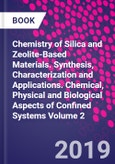Chemistry of Silica and Zeolite-Based Materials covers a wide range of topics related to silica-based materials from design and synthesis to applications in different fields of science and technology. Since silica is transparent and inert to the light, it is a very attractive host material for constructing artificial photosynthesis systems. As an earth-abundant oxide, silica is an ideal and basic material for application of various oxides, and the science and technology of silica-based materials are fundamentally important for understanding other oxide-based materials. The book examines nanosolvation and confined molecules in silica hosts, catalysis and photocatalysis, photonics, photosensors, photovoltaics, energy, environmental sciences, drug delivery, and health.
Written by a highly experienced and internationally renowned team from around the world, Chemistry of Silica and Zeolite-Based Materials is ideal for chemists, materials scientists, chemical engineers, physicists, biologists, biomedical sciences, environmental scientists, toxicologists, and pharma scientists.
---
"The enormous versatility of silica for building a large variety of materials with unique properties has been very well illustrated in this book.. The reader will be exposed to numerous potential applications of these materials - from photocatalytic, optical and electronic applications, to chemical reactivity in confined spaces and biological applications. This book is of clear interest not only to PhD students and postdocs, but also to researchers in this field seeking an understanding of the possible applications of meso and microporous silica-derived materials." - Professor Avelino Corma, Institute of Chemical Technology (ITQ-CSIC) and Polytechnical University of Valencia, Spain
Please Note: This is an On Demand product, delivery may take up to 11 working days after payment has been received.
Table of Contents
1. Synthesis and application of periodic mesoporous organosilicas Shinji Inagaki, Norihiro Mizoshita, Yoshifumi Maegawa and Masamichi Ikai 2. Silica hosts for organosilanes: preparation, characterization and catalytic application Maria Zi�lek and Katarzyna Stawicka 3. Catalytic interconversion of sugars with zeolite and zeotype materials Shunmugavel Saravanamurgan, Fenghua Wang, Hu Li, Fusheng Xu and Zhaozhuo Yu 4. The microwave assisted synthesis of silica-based materials and their photocatalysis Bernaurdshaw Neppolian, Vinesh V. and Masakazu Anpo 5. Silica-based materials for photocatalysis Trong-On Do and Sakar Mohan 6. Photocatalytic reactions on transition metal-oxide single site heterogeneous catalysts constructed within silica-networks of MCM-41 Masakazu Anpo and Shinya Higashimoto 7. Silica-supported immobilized amine for CO2 capture processes Steven Chuang, Yuxin Zhai and Hailiang Jin 8. Silica-based catalysts for fuel applications Paula S�nchez, Ana Raquel de la Osa, Fernado Dorado and J. M. Garcia-Vargas 9. Photochromic reactions in nanospace: Host-guest interaction and opportunity Makoto Ogawa and Tetsuo Yamaguchi 10. Dyes encapsulated within porous aluminosilicates as photocatalysts Hermenegildo Garcia and Josep Albero 11. Controlling photoreactions with confined spaces and cations: zeolites as the reaction media Shuichi Hashimoto 12. Silica-based materials for bioanalytical chemistry and optoelectronics Anindya Datta, Subhasree Banerjee, Anjali Dhir and Hemen Gogoi 13. Dye encapsulation into one-dimensional zeolitic materials for optical applications Virginia Martinez, Rebeca Sola-Llano, Leire Gartzia-Rivero, Ainhoa Oliden-Sanchez, Jorge Ba�uelos and I�igo L�pez Arbeloa 14. Electron transfers under confinement in channel type zeolites Alain Moissette, Matthieu Hureau, Herv� Vezin and Raul F. Lobo 15. Electronic and molecular motions in silica-material hosts Abderrazzak Douhal, Maria Rosaria di Nunzio and Mario Gutierrez Tovar 16. Electronic confinement of dyes in silica materials Boiko Cohen and Abderrazzak Douhal 17. Mesostructured silica-based materials as host for optically active semiconductors Anastasia Vassilakopoulou and Ioannis Koutselas 18. Photoactive metal-containing zeolitic materials for sensing and light-to-chemical energy conversion Vincent De Waele and Svetlana Mintova 19. Characterization of amorphous silica-based materials using DFT computational methods Frederik Tielens 20. Zeolites and mesoporous silica: From synthesis to surface chemistry of environmental and biological interactions Sarah Larsen, Majid Nada, Sanjaya Jayalath and Vicki Grassian 21. Engineered stimuli-responsive nanoparticles for the interaction with biological structures Luigi Pasqua, Antonella Leggio and Catia Morelli 22. Focal treatment in prostate cancer with anti-PSMA labeled mesoporous silica nanoparticles Pablo Botella, Eva M. Rivero-Buceta, C�sar-David Vera Donoso and Victoria Moreno Manzano
Authors
Abderrazzak Douhal Professor, Department of Physical Chemistry, Faculty of Environmental Science and Biochemistry, University of Castilla-La Mancha - Toledo, Spain. Abderrazzak Douhal has been studying the photochemistry and photophysics of composites using silica-based materials for many years. He published around 200 articles, and co-edited 3 books. He is serving in the editorial board of several international journals. For his work on the photochemistry of silica-based materials, he was awed by the International Association for Advanced Materials (2016), and by the Japanese Photochemistry Association (2018) for his work on the photochemistry of MOFs. For the last 3 decades, his research work focused on femtochemistry in liquids and confining media. His recent interest is deserved to elucidating the ultrafast spectroscopy and microscopy of hydrogen-bonded organic frameworks (HOFs), metal-organic frameworks (MOFs) and applications of their composites to lighting and sensing. Masakazu Anpo Emeritus Professor, Osaka Prefecture University - Osaka, JapanSpecial Honor Professor and International Advisor, Fuzhou University - Fuzhou, China. Masakazu Anpo is a Professor Emeritus of Osaka Prefecture University (ex-Vice President & Executive Director) since 2015 (Osaka, Japan) and a Special Honored Professor & International Advisor at Fuzhou University (Fuzhou, China) since 2015. He is a pioneer in the research of photochemical reactions on solid surfaces, the design of highly efficient visible-light-responsive TiO2 photocatalysts, and single-site transition metal oxide photocatalysts constructed within the framework of zeolites and mesoporous materials for the issues of environment and energy. He is the editor-in-chief of the international journal Res. Chem. Intermed. (Springer), and has published many books such as "Photochemistry on Solid Surfaces� (1989, Elsevier), "Environmentally Bengin Photocatalysis� (2014, Springer) and reviews such as Chem. Rev., 114 (2014), Adv. Inorg. Chem., 72 (2018). He is a member of Academia Europaea and Science Council of Japan.








